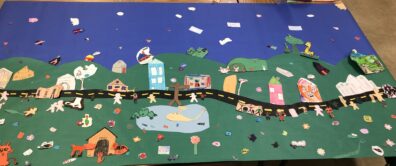Art for Social Change and SLCR Lecture Series
ASC 2021
The Art for Social Change competition is organized by the School of Languages, Cultures, and Race every spring. Despite various restrictions from the pandemic, the competition went ahead, serving as further proof of our students’ resilience and motivation. Although we could not organize a showcase to celebrate our awardees, you can see their winning pieces and read about what inspired them, below.
We are already looking forward to the next ASC competition in spring 2022! If you would like to enter your artwork, check out the submission guidelines.
Community Outreach:
This award is given to an art work that builds bridges between WSU (or the WSU community and individuals) and other communities.

First Place: Pullman School District
Led by teacher Desiree Gould, Franklin Grade School students created this fantastic piece titled Everyone Deserves a Home. According to Gould, “Homelessness can reflect biases and injustices present in communities. All students in the Pullman School District were invited to create artwork for a combined mural emphasizing that everyone deserves a home.”







